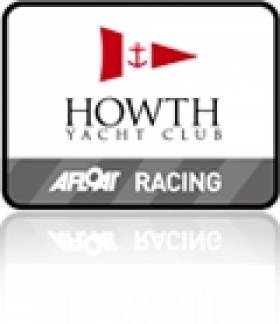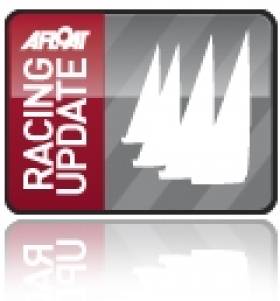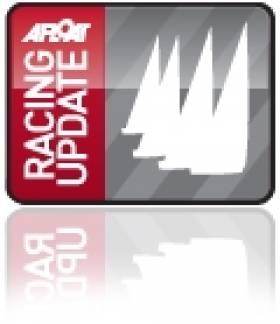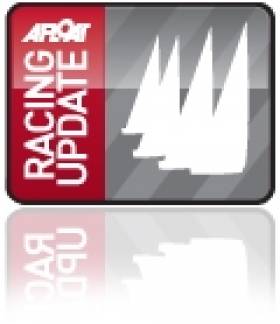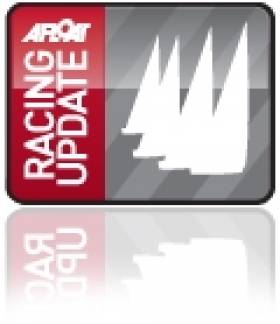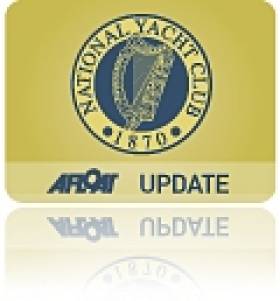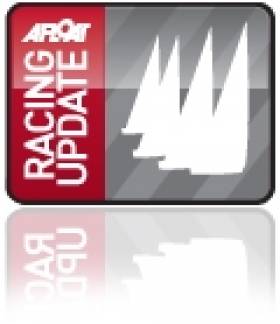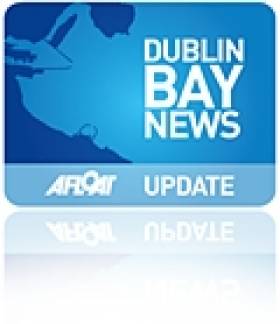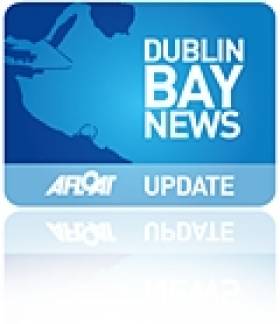Displaying items by tag: moth
Strong Winds Make Irish Moth Sailors Fly at Howth Yacht Club
#moth – Maybe it's the fun factor, maybe its the fear factor – Graeme Grant braved the strong winds off Howth today to sail his Moth foiling dinghy on the first day of the inaugural Moth Irish Championships.
Capable of sailing at over 30 knots, Grant demonstrates the foiling dinghy (pictured above) that has captured the imagination of a number of Irish dinghy sailors and led to this weekend's first gathering of hydrofoil sailors in Ireland.
Four International Moths are sailing from Dun Laoghaire on a regular basis. Dun Laoghaire boats usually take part in the DBSC summer series PY racing along side a growing fleet of 49ers. The number includes Laser European Champion Annalise Murphy.
One Fastacraft Zero sails from Blessington Sailing Club, in County Kildare. Blessington offers a great place to learn to sail Moths in flat lake water with the safety of the shore never too far away.
One Ninja based in Howth is sailed by Graeme Grant.
Built almost entirely out of carbon fibre, the International Moth is the most technically advanced racing dinghy in the world. With an all up weight of around 30 kilograms, the boat is designed and built to fly.
The International development sailing class has a history of 75 years of continuous innovation.
Howth Hosts Moths For 2013 Irish Open Next Weekend
#Moths - If you enjoyed all the action of the America’s Cup recently, you'll be sure to love watching the Moths racing in Howth for the 2013 Irish Open next weekend.
Howth Yacht Club will play host to the event on 2-3 November for the international Moths, foiling single-handed boats that are very fast and incredibly exciting to sail - and to watch!
Spectator boats will be available on both days of the event, and the organisers will do their best to facilitate anyone interested in being on board - contact Laura Dillon at [email protected] indicating which day you would prefer to watch.
Organisers are also hoping to have some video footage playing in the bar on Saturday evening after the day's racing, and all are welcome to attend.
In addition, organisers are looking for a number of yachts, motor boats and RIBs to take some spectators out - anyone willing to volunteer should contact Laura Dillon via the email address above as soon as possible.
Moth Crown for Gulari, the 2013 Foiling Dinghy World Champion
#moth – An early squall drenched the 80 competitors for the 2013 McDougall + McConaghy International Moth World Championship this morning as they prepared their flying carbon-fiber craft for the final day of racing. The rain and clouds brought with them an unfortunate side effect, cooling down Oahu's Koʻolau Mountains and shutting down the building thermal breeze that might have allowed a final day of racing for the Moth World title.
Ireland's Annalise Murphy and Ryan Seaton, the furthest travelled of all competitors to the Hawaii venue, finished 74 and 73 respectively. Results here
After a tense 3-hour wait in the Kaneohe Yacht Club boat park, Race Officer Tom Pochereva reached for the treble horn that indicates the end to the regatta; within seconds, a dozen American racers lifted Michigan's Bora Gulari in the air and tossed him in the club pool for the 2013 World Champion's ceremonial dunking.
Gulari becomes the first American two-time Moth World Champion since 1959; he won the 2009 World Championship in Cascade Locks, Oregon.
Gulari attributes his success to his Mach 2 Moth, which he says "is a perfect platform for this kind of sailing," combined with the cumulative effect of dozens of small changes to the boat. "We've been working for a solid year in Detroit, refining and changing things bit by bit until they're perfect," said Gulari. He also gave credit to his sail package, adding "North Sails and specifically sailmaker Chris Williams came up with an extremely powerful sail design for this Worlds; I've never sailed with a faster sail since I bought my first Moth."
Final Results:
1. Bora Gulari, USA, 21 points
2. Nathan Outteridge, AUS, 29
3. Scott Babbage, AUS, 44
4. Ben Paton, GBR, 45
5. Robert Greenhalgh, GBR, 46
6. Rob Gough, AUS, 50
7. Chris Rashley, GBR, 50
8. Julian Salter, AUS, 55
9. Brad Funk, USA, 71
10. Peter Burling, NZL, 77
One Moth Destroyed, Others Damaged & Amazing Racing Action
#mothworlds – Today's McDougall & McConaghy Moth World Championship highlight reel features the most exciting action yet from Kaneohe Bay. One boat destroyed, quite a few damaged, and amazing racing action as Detroit's Bora Gulari overhauls Aussie Nathan Outteridge for the lead. Produced/edited/directed by Peter Crawford/Penalty Box Productions.
Moth Worlds, Calm Wind Foils Fleet
#moth – An 8-knot easterly breeze swept through Kaneohe Bay just after noon today, providing a glimmer of hope for day one of the 2013 McDougall + Maconaghy Moth World Championship fleet despite a dire forecast. With conditions forecast to build slightly throughout the day, Race Officer Tom Pochoreva and his Kaneohe Yacht Club-based team jumped on the chance for a solid race between two squalls shortly after 1230 PM. "The fleet was foiling around and sailing fast for a while, but when the wind started to die we realized we couldn't get a fair race in and we pulled the plug," said Pochoreva. "Things are looking better and better for the rest of the week, and we're looking forward to some great action tomorrow."
Proving the conventional wisdom accurate, the British contingent showed strong speed in the light air, with Robert Greenhalgh and Tom Offer trading the lead around the course despite leaving the start line nearly 3 minutes late. "I was a bit confused about the course signals and ended up very late for the start," said Greenhalgh, who at one point was nearly a half leg ahead of the next competitor even after giving the fleet a head start. "The boat is going really well, and I was able to get on the foils and stay there after much of the fleet dropped down into low-riding mode."
Tuesday's weather outlook has improved significantly, with most models showing more wind than previously forecast. "We're looking at around 8-10 knots tomorrow, with up to 12 knots on Thursday," said an optimistic Pochereva.
For a breakdown of the likely Top Ten for this year's Worlds fleet, check two-time World Champ Simon Payne's insightful breakdown of the Moth Worlds fleet here. You can find names, sail numbers, and origin for each competitor here.
Racing begins at 1200 tomorrow, with up-to-the-minute coverage on the Moth Worlds Facebook Page. You can find photo galleries of Nationals, Practice, World Championship racing in the Moth World Galleries here.
Photos are rights-free for editorial use only to a maximum half page size.. Mandatory credit to read ©ThMartinez/Sea&Co/Moth World Championship.
Clean Racing Tip Of The Day
As one of the world's most elite racing classes, the International Moth Class believes it essential to emphasize the responsible use of energy and resources in the context of sailing. Working with 11th Hour Racing, a program of the Schmidt Family Foundation, the Moth Class has come up with a number of initiatives to help all sailing events improve the energy profile and performance of racing boats and increase the personal investment of sailors in the health of our waters.
Each day, the Moth Worlds fleet will highlight a 'Clean Racing Tip' they've implemented; something that will work for regattas and racing classes around the world. Here's today's tip:
SMART SHIPPING: Encourage competitors to ship their boats together, using surface freight whenever possible. This will cut down significantly on carbon emissions and the regatta's carbon footprint. Likewise, try to make local charter boats available for competitors from far away. For local sailors, lending or sharing your boat with a 'rock star' from another part of the country or world is a great way to get your boat tuned up and up to speed.
National Yacht Club to Promote Skiff & Foiling Sailing at Special Presentation Evening
#foiling– Interested in those skiffs or mad foiling machines? Dublin's National Yacht Club (NYC) is taking a leading role in developing high performance dinghy sailing by organising a presentation evening and debate at its Dun Laoghaire clubhouse on the subject of faster sailing. Former youth champion Ben Lynch (and older brother of Finn, the Laser U21 world champion) is organising the session on Friday, 4th October at 18:30 in the NYC.
The aim of the "JUST DO IT" initiative, according to sailing manager Olivier Proveur, is to 'spark something useful for all sailors interested in going a bit faster...'
The programme will cover how to get started and will cover Skiffs, 49er, 29ers and Moth dinghy sailing. (Don't forget the foiling Laser, Ben – Ed)
A programme and poster for the session is available for download below. The go-ahead club was previously in the vanguard of promoting solo and short–handed sailing and held a similar evening at the NYC in December 2009. This Summer it hosted the Route des Princes stop over, a round Europe race for ultra fast trimarans that had more than its fair share of drama on Dublin Bay.
The objectives of the October evening are:
- To inform potential new comers
- To see what level of interest there is to get into that scene...create an attendance / database list
- To detail what we are trying to achieve by coming together and what are potential routes to continue on from here if interested. (Create Yahoo Group? Facebook page? Committing to program to get involved with particular boats or to try a few, training hard in one class to perform)
- To promote the around the island challenge
- To explore the room to develop a series for Hi Perf Dinghies in Dun Laoghaire, within or outside of DBSC, elsewhere in Ireland....
Currently, club members Tadhg and Sean Donnelly are campaigning a 29er dinghy and the NYC's Olympic sailor Annalise Murphy is heading to Hawaii shortly for the Moth World championships.


Irish Moth Sailors Sail to UK Silver Fleet Success
#moth – Irish Moth sailors, including London Olympian Annalise Murphy, joined the 30–knot club last weekend at the biggest ever UK Moth National championships held in Weymouth. The foiling class, introduced into Dublin Bay by Jon Chambers in 2011 is attracting something of a cult following both here and in the UK. A number of the space age craft now grace the deck of the National Yacht Club.
Noted British Volvo Ocean Race, Olympic and Extreme 40 sailor, Rob Greenhalgh emerged the winner of the 12-race series at Castlecove Sailing club in Portland harbour.
Greenhalgh said afterwards 'Absolutely delighted with the win against some great sailors; Chris Rashley, Simon Hiscocks, Mike Lennon, Jason Belben and Tom offer. All these guys are so quick and it was full on. I just love the racing and it was very satisfying to have everything click into place at Weymouth'.
There was some Irish success too in the 70–boat fleet with 2004 Athens Olympic Laser sailor, Rory Fitzpatrick winning the silver fleet, in 23rd place overall. Jon Chambers, pictured above, was 35th overall. Annalise Murphy. who bought a Moth last season finished 61st but did not compete in the first six races. Results here.
Irish Sailing Star Annalise Goes Hydrofoil 'Moth' Sailing
#annalise – Afloat's Irish sailor of the year Annalise Murphy is the latest sailor to bite the bullet on the hydrofoil sailing Moth dinghy craze.
Annalise who competes at the ISAF World Cup in Palma at the end of this month was on the Ulysses car ferry last week heading for Holyhead to pick up her new boat!
The Moth Class is the name for a small development class sailing dinghy. There are three types of moths and possibly up to 5 currently in existence: the International Moth, a fast sailing hydrofoil dinghy
Annalise, who finished fourth at the London Olympics and is campaigning again for the 2016 Olympics says she is 'learning how to sail all over again'.
The 23–year–old National Yacht Club sailor has just been awarded €40,000 in funding as a 'podium athlete' by the Irish Sports Council.
She spent a lot of time 'cart-wheeling' around Dun Laoghaire Harbour, much to the amusement of other the local DMYC Frostbite fleet.
Other international Laser stars such as triple world Laser Champion and Olympic Gold medallist Tom Slingsby have found sailing the foiling craft helps their Laser technique.
Annalise is not the first to sail the hydrofoiling craft in Ireland. In 2011 the Moth made its debut in Irish waters.
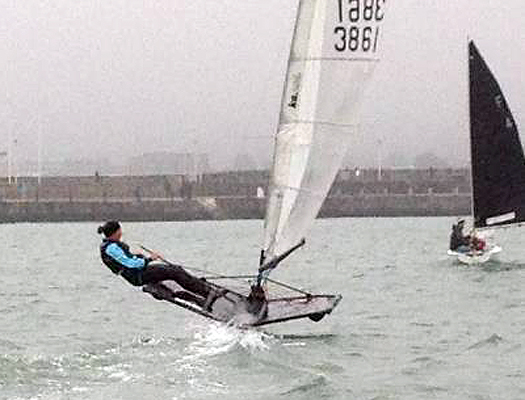
Annalise gets to grips with the hydrofoil
Dun Laoghaire Moth Sailor on a Wing and a Prayer
#MOTH – Progress towards establishing a Moth class in Dun Laoghaire continues with news that two of the high flying craft are entered in to the 2012 Dublin Bay Sailing Club (DBSC) summer series. Promoted by Dublin sailor John Chambers the craft first appeared on Irish waters in 2011 when the Bladerider Moth was spotted blasting across Dublin Bay. It has hydrofoils on the dagger board and rudder which lift the boat out of the water when sufficient speed is achieved.
Since then Chambers has been keen to get more dinghy sailors to have a go in the airborne craft. This latest winter video was shot in just 12-knots of breeze and although gybing looks tricky enough Chambers maintains the boat is easy to handle, a point he is keen to let readers know.
Moth Dinghy Debuts on Dublin Bay
Since our report on Ireland's debut at the Moth worlds in January it was inevitable that one of these high speed sailing dinghies would appear on Irish waters soon enough. Yesterday, John Chambers took his first tack of 2011 on Dublin Bay in a Moth he bought in France. Clearly the high speed foiling craft did not go unnoticed. It got an immediate thumbs up from the nearby DMYC frostbite fleet sailing their penultimate race.
The Bladerider Moth came blasting back from the Baily lighthouse, according to eyewitness accounts. It has hydrofoils on the dagger board and rudder which lift the boat out of the water when sufficient speed is achieved.
It is Chamber's intention to sail the innovative dinghy in this Summer's Dublin Bay Sailing Club (DBSC) summer season.
Video of the Dublin Bay sail plus a photo from Bob Hobby is below:
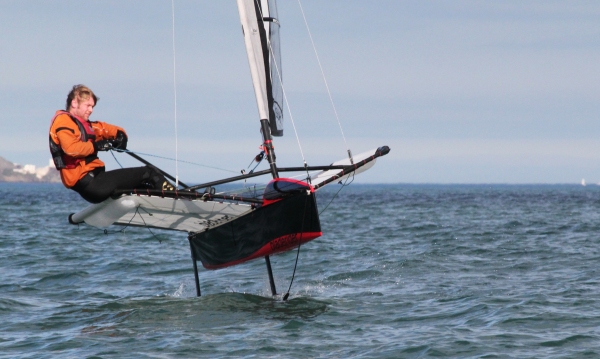
Moth sailing on Dublin bay. Photo: Bob Hobby
Moth sailing in Ireland on facebook HERE


























